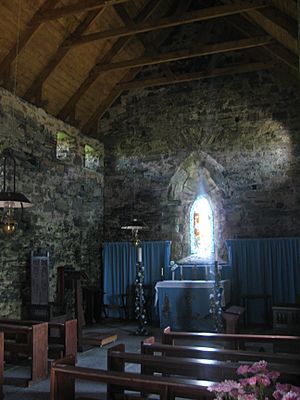Teampall Mholuaidh facts for kids
Quick facts for kids Teampall Mholuaidh (St Moluag's Church) |
|
|---|---|

Teampall Mholuaidh, 13th Century church in the village of Eoropie
|
|
| Denomination | Episcopalian |
| History | |
| Dedication | St Moluag |
St Moluag's Church, also known as Teampall Mholuaidh in Scottish Gaelic, is a historic church. You can find it in the village of Eoropie in Ness. This area is part of the Isle of Lewis in Scotland. It's a very popular place for visitors in Ness. People love to visit because it's important to history and easy to reach from the main road.
Contents
History of St Moluag's Church
Experts believe this church was built a long time ago. Some think it was built between the 12th and 16th centuries. Small digs in the 1970s didn't find clear proof of its exact age. The church has a simple T-shape. It has two small chapels, one on each side of the main building. You can only get into the southern chapel from outside. Outside the church, there's a war memorial. It looks like a traditional Celtic cross.
Restoring the Church
The church was carefully fixed up in 1911 and 1912. James S. Richardson was in charge of this work. The pulpit, which is where the minister speaks, and the altar, where services are held, were added in 1911. The font, used for baptisms, also dates from 1911.
The Church Today
Today, St Moluag's Church is used by the Scottish Episcopal Church. Regular church services started again in 1994. During the cold winter months, the church doesn't have heating or proper lighting. Because of this, services are held in a different building in Tong during winter. People traditionally see this church as the special church for the MacLeod family.
Other Churches Nearby
There are old ruins of another church called "Teampall Ronaidh." These ruins are about 500 meters (about 1,640 feet) northeast of Teampall Mholuaidh. You can also find the remains of "Teampall Pheadair." This old church is about 2 kilometers (about 1.2 miles) southwest of St Moluag's. It's located near an old graveyard close to the village of Swainbost.
Healing Traditions at the Church
One of the most interesting stories about St Moluag's Church is its power for healing. Many people believed it could help those with mental health problems. People would bring sick family members here hoping they would get better. Even if someone couldn't come to the church, they would send wooden models of their sick body parts. In 1630, a visitor named Captain Dymes wrote about this. He saw these wooden models lying on the altar of the chapel. They showed the sick arms or legs of people who couldn't visit the church themselves.


